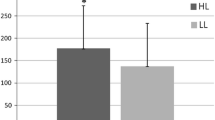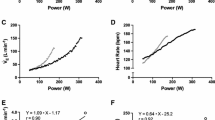Summary
The purpose of this study was to examine the effect of one- and two-leg training on arm and two-leg maximum aerobic power. Seven subjects cycle-trained both legs simultaneously for 30 min·day−1, 4 days·week−1 for 4 weeks. Nine subjects cycle-trained each leg 15 min·day−1, 4 days· week−1 for 4 weeks. Both groups trained at a heart rate equal to that measured at 75% of their two-leg maximum aerobic power. Thus, during each training session the groups performed 30 min of work at the same heart rate intensity. Five subjects served as a non-training control group. Arm and leg maximum oxygen uptake tests were conducted before and after training. Only two-leg training induced significant gains in arm aerobic power (P<0.0003), whereas both modes of training resulted in signifcant increases in two-leg aerobic power (P<0.0008). The data demonstrate that improvements in arm aerobic power were dependent on the quantity of leg muscle mass involved in the training, whereas gains in two-leg aerobic power occurred regardless of whether the legs were trained separately or simultaneously.
Similar content being viewed by others
References
Alhborg G, Hagenfeldt L, Warren J (1976) Substrate utilization by inactive leg during one-leg and arm exercise. J Appl Physiol 39:718–723
Clausen J (1977) Effect of physical training on cardiovascular adjustments in man. Physiol Rev 57:779–815
Clausen J, Klausen K, Rasmussen B, Trap-Jensen J (1973) Central and peripheral circulatory changes after training of the arms or legs. Am J Physiol 225:675–682
Davies C, Sargeant A (1975) Effects of training on the physiological responses to one and two-leg work. J Appl Physiol 38:377–381
Freedson P, Kline G, Porcari J, Hinter-Meister R, McCarran R, Ross J, Ward A, Gurry M, Rippe J (1986) Citeria for defining VO2max: a new approach to an old problem. Med Sci Sports Exerc 18:S36
Huck S, Cormier W, Bounds W (1974) Reading statistics and research. Harper & Row, New York, pp 46, 54 and 135
Issekutz B, Birkhead W, Rodahl K (1962) Use of respiratory quotients in assessment of aerobic work capacity. J Appl Physiol 17:47–50
Klausen K, Secher N, Clausen J, Hartling O, Trap-Jensen J (1982) Central and regional circulatory adaptations to one-leg training. J Appl Physiol 52:976–983
Lewis S, Thompson P, Areskog N, Vodak P, Marconyak M, Debusk R, Mellen S, Haskell W (1980) Transfer effects of endurance training to exercise with untrained limbs. Eur J Appl Physiol 44:25–34
McArdle W, Katch F, Pechar G (1973) Comparision of continuous and discontinuous treadmill and bicycle tests for Max VO2. Med Sci Sports 5:156–160
Rösler K, Hoppeler H, Conley K, Claassen H, Gehr P, Howald H (1985) Transfer effects in endurance exercise. Eur J Appl Physiol 54:355–362
Saltin B, Nazar K, Costill D, Stein E, Jansson E, Essen B, Gollnick P (1976) The nature of the training response; peripheral and central adaptations to one-legged exercise. Acta Physiol Scand 96:289–305
Sawka M, Foley M, Pimental N, Toner M, Pandolf K (1983) Determination of maximal aerobic power during upper body exercise. J Appl Physiol 54:113–117
Stamford B (1975) Maximal oxygen uptake during treadmill walking and running at various speeds. J Appl Physiol 39:386–389
Taylor H, Buskirk E, Henscel A (1955) Maximum oxygen intake as an objective measure of cardio-respiratory performance. J Appl Physiol 8:73–80
Author information
Authors and Affiliations
Rights and permissions
About this article
Cite this article
Swensen, T.C., Howley, E.T. Effect of one- and two-leg training on arm and two-leg maximum aerobic power. Europ. J. Appl. Physiol. 66, 285–288 (1993). https://doi.org/10.1007/BF00235108
Accepted:
Issue Date:
DOI: https://doi.org/10.1007/BF00235108




